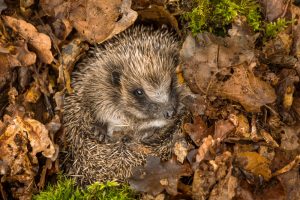Things to Know About Hedgehog & Badger Hibernation
13th September 2019

September means it’s time for hibernating animals to get themselves ready for their long slumber. This will include building up weight for warmth through the cold months and looking for shelter. One species that are well known for their hibernation habits are hedgehogs, however, badgers also take part in hibernation practices to help them through the winter season. Here are a few things you need to know about hedgehog and badger hibernation to help them through their long sleep.
What happens during hibernation?
It’s a common misconception that hedgehogs sleep through the winter for hibernation. In actuality, hedgehogs will drop their body temperature to match their surroundings and enter a state of torpor. This will allow them to save a lot of energy but slows down all other bodily functions making normal activity impossible. Before this process begins, hedgehogs will be spending their time building up their body fat as much as possible. That’s why you must provide your local hedgehogs with as much food and water as possible before hibernation begins.
Badgers don’t hibernate, but similar to hedgehogs, they do spend the autumn/early-winter period building up their body weight. This is done to help them through the winter when food sources are scarce. They do also spend more of their time underground, however, they don’t sleep through the winter and will regularly leave their sett to find whatever food they can. This is why you should continue to leave out food for badgers throughout the year, as they will be struggling to find food sources during the winter months.
Where does hibernation happen?
Badgers are creatures of habit, and so they will usually find a home for themselves underground, or as they’re known, a “sett”. Though badgers will leave their setts regularly to continue looking for food sources, they will spend most of their time underground where it is warm and safe.
Hedgehogs will have to be more selective about their hibernation spot, as they don’t have the luxury of digging underground to find themselves a home. Typically, hedgehogs will use warm secluded areas around the local areas, and sometimes even in your garden. This can be places like log or leaf piles, compost heaps and underneath sheds. So make sure you check areas like this for any hedgehogs hibernating before moving them, but also be sure not to disturb them. If you want to go the extra mile to help hedgehogs during hibernation, take a look here to discover how to build your own hedgehog house, providing your local hoggies with a safe, secure and warm hibernation spot.
How can I help during hibernation?
As badgers don’t sleep through the whole hibernation period and are still looking for food, you must regularly put out food and water. The winter weather will take its toll, and so badgers will need as much food as they can get to keep their body weight up and remain warm.
As hedgehogs will be in a state of torpor and won’t be leaving their hibernation spot, you won’t need to put out food as much as you do through the rest of the year. However, some hedgehogs may wake early from their sleep on mild days when the cold isn’t as harsh. Therefore, you should still regularly put out water and food on warmer days for any early-waking hedgehogs.


